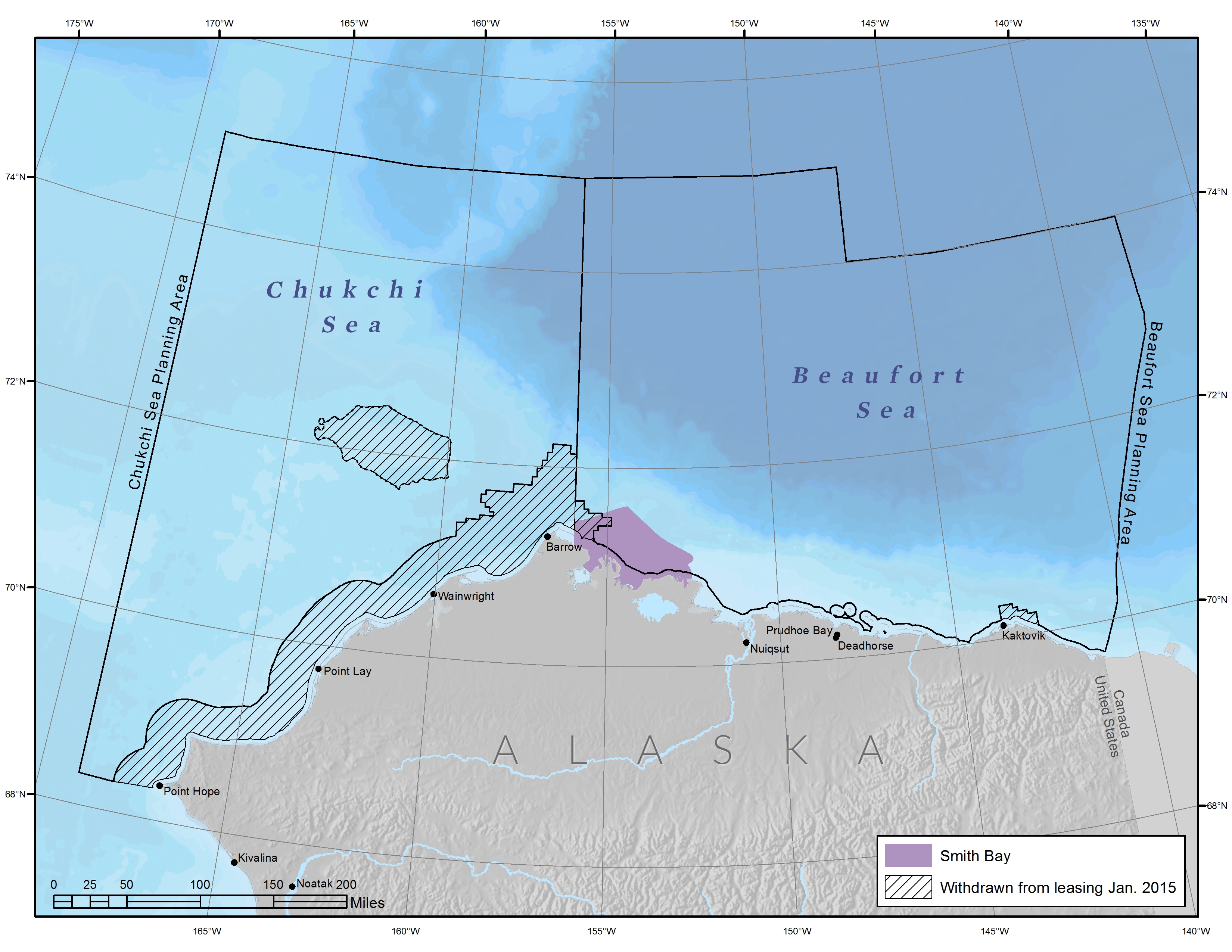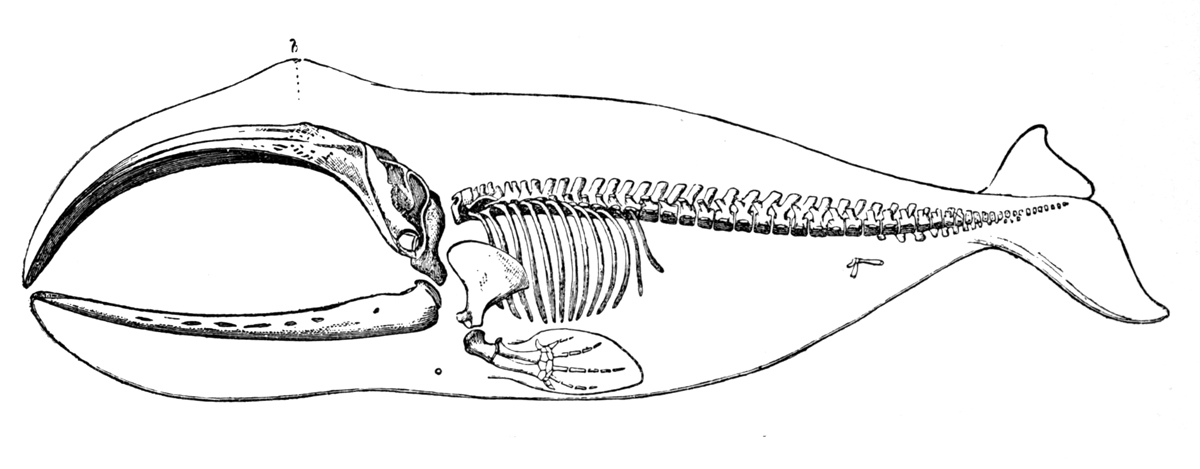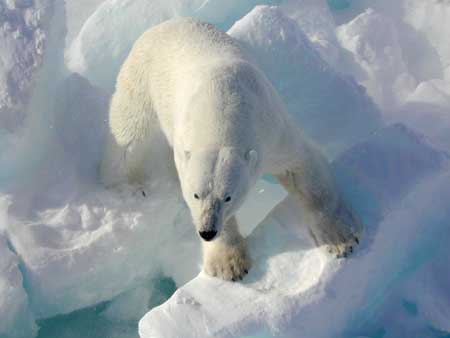|
Smith Bay
Smith Bay is an estuary in the Beaufort Sea that supports a wide range of fish, birds, and marine mammals. It is located northeast of Point Barrow, Alaska. The Bureau of Ocean Energy Management recognizes the southeastern portion of Barrow Canyon, which covers some, but not all, of Smith Bay, as an Environmentally Important Area. Geography Approximately 150 miles west of Prudhoe Bay, Alaska, Smith Bay stretches from Dease Inlet, Alaska to Cape Halkett, Alaska. Bordered by barrier islands that separate the shallow, brackish waters from the Beaufort Sea, several slow-moving rivers flow into this region. Along with its adjacent waters, Smith Bay is a shallow-water estuary. Fauna Smith Bay is a significant hotspot for pinnipeds. The nearshore areas are important habitat for ringed seals that come to the landfast ice during the winter and spring to give birth. Polar bears and bowhead whales rely on Smith Bay for important foraging habitat. Polar bears have been observed using Smi ... [...More Info...] [...Related Items...] OR: [Wikipedia] [Google] [Baidu] |
Estuary
An estuary is a partially enclosed coastal body of brackish water with one or more rivers or streams flowing into it, and with a free connection to the open sea. Estuaries form a transition zone between river environments and maritime environments and are an example of an ecotone. Estuaries are subject both to marine influences such as tides, waves, and the influx of saline water, and to fluvial influences such as flows of freshwater and sediment. The mixing of seawater and freshwater provides high levels of nutrients both in the water column and in sediment, making estuaries among the most productive natural habitats in the world. Most existing estuaries formed during the Holocene epoch with the flooding of river-eroded or glacially scoured valleys when the sea level began to rise about 10,000–12,000 years ago. Estuaries are typically classified according to their geomorphological features or to water-circulation patterns. They can have many different names, such as bays, ... [...More Info...] [...Related Items...] OR: [Wikipedia] [Google] [Baidu] |
Bowhead Whale
The bowhead whale (''Balaena mysticetus'') is a species of baleen whale belonging to the family Balaenidae and the only living representative of the genus ''Balaena''. They are the only baleen whale endemic to the Arctic and subarctic waters, and are named after their characteristic massive triangular skull, which they use to break through Arctic ice. Other common names of the species are the Greenland right whale, Arctic whale, and Arviq in aboriginal languages ( Inuktitut). American whalemen called them the steeple-top, polar whale, or Russian whale. Bowheads have the largest mouth of any animal representing almost one-third of the length of the body, the longest baleen plates with a maximum length of and may be the longest-lived mammals, with the ability to reach an age of more than 200 years. The bowhead was an early whaling target. Their population was severely reduced before a 1966 moratorium was passed to protect the species. Of the five stocks of bowhead population ... [...More Info...] [...Related Items...] OR: [Wikipedia] [Google] [Baidu] |
Oil Seep
A petroleum seep is a place where natural liquid or gaseous hydrocarbons escape to the earth's atmosphere and surface, normally under low pressure or flow. Seeps generally occur above either terrestrial or offshore petroleum accumulation structures. The hydrocarbons may escape along geological layers, or across them through fractures and fissures in the rock, or directly from an outcrop of oil-bearing rock. Petroleum seeps are quite common in many areas of the world, and have been exploited by mankind since paleolithic times. Natural products associated with these seeps include bitumen, pitch, asphalt and tar. In locations where seeps of natural gas are sufficiently large, natural "eternal flames" often persist. The occurrence of surface petroleum was often included in location names that developed; these locations are also associated with early oil and gas exploitation as well as scientific and technological developments, which have grown into the petroleum industry. Hi ... [...More Info...] [...Related Items...] OR: [Wikipedia] [Google] [Baidu] |
Long-tailed Duck
The long-tailed duck (''Clangula hyemalis''), formerly known as oldsquaw, is a medium-sized sea duck that breeds in the tundra and taiga regions of the arctic and winters along the northern coastlines of the Atlantic and Pacific Oceans. It is the only member of the genus ''Clangula''. Taxonomy The long-tailed duck was formally described by the Swedish naturalist Carl Linnaeus in 1758 in the tenth edition of his ''Systema Naturae''. He placed it with all the other ducks in the genus ''Anas'' and coined the binomial name ''Anas hyemalis''. Linnaeus cited the English naturalist George Edwards's description and illustration of the "Long-tailed duck from Hudson's-Bay" that had been published in 1750 in the third volume of his ''A Natural History of Uncommon Birds''. This duck is now the only species placed in the genus ''Clangula'' that was introduced in 1819 to accommodate the long-tailed duck by the English zoologist William Leach in an appendix to John Ross's account of his vo ... [...More Info...] [...Related Items...] OR: [Wikipedia] [Google] [Baidu] |
Sabine’s Gull
Sabine's gull ( ) (''Xema sabini'') also known as the fork-tailed gull or xeme, is a small gull. It is the only species placed in the genus ''Xema''. It breeds in colonies on coasts and tundra, laying two or three spotted olive-brown eggs in a ground nest lined with grass. Sabine's gull is pelagic outside the breeding season. It takes a wide variety of mainly animal food, and will eat any suitable small prey. Taxonomy Sabine's gull was formally described in 1819 by the naturalist Joseph Sabine under the binomial name ''Larus sabini''. Sabine based his description on specimens that had been collected by his brother Captain Edward Sabine who had accompanied Captain John Ross's on a voyage to look for the Northwest Passage. The birds were found breeding on low lying islands off the west coast of Greenland in July 1818. Sabine's gull is now the only species placed in the genus ''Xema'' that was introduced in 1819 by the zoologist William Leach in an appendix to Ross's account of t ... [...More Info...] [...Related Items...] OR: [Wikipedia] [Google] [Baidu] |
Glaucous Gull
The glaucous gull (''Larus hyperboreus'') is a large gull, the second-largest gull in the world. It breeds in Arctic regions of the Northern Hemisphere and winters south to shores of the Holarctic. The genus name is from Latin ''larus'', which appears to have referred to a gull or other large seabird. The specific name ''hyperboreus'' is Latin for "northern" from the Ancient Greek ''Huperboreoi'' people from the far north "Glaucous" is from Latin ''glaucus'' and denotes the grey colour of the gull. An older English name for this species is burgomaster. This gull is migratory, wintering from in the North Atlantic and North Pacific Oceans as far south as the British Isles and northernmost states of the United States, also on the Great Lakes. A few birds sometimes reach the southern USA and northern Mexico. Description This is a large and powerful gull, second-largest of all gull species and very pale in all plumage, with no black on either the wings or the tail. Adults are pal ... [...More Info...] [...Related Items...] OR: [Wikipedia] [Google] [Baidu] |
Black-legged Kittiwake
The black-legged kittiwake (''Rissa tridactyla'') is a seabird species in the gull family Laridae. This species was first described by Carl Linnaeus in his landmark 1758 10th edition of ''Systema Naturae'' as ''Larus tridactylus''. The English name is derived from its call, a shrill 'kittee-wa-aaake, kitte-wa-aaake'. The genus name ''Rissa'' is from the Icelandic name ''rita'' for this bird, and the specific ''tridactyla'' is from Ancient Greek ''tridaktulos'', "three-toed", from ''tri-'', "three-" and ''daktulos'', "toe". In North America, this species is known as the black-legged kittiwake to differentiate it from the red-legged kittiwake, but in Europe, where it is the only member of the genus, it is often known just as kittiwake. Range and distribution The black-legged kittiwake is a coastal bird of the arctic to subarctic regions of the world.del Hoyo, J; Elliott, A; Sargatal, J (1996). ''Handbook of the Birds of the World Vol. 3''. Barcelona: Lynx Edicions. pp. 622–62 ... [...More Info...] [...Related Items...] OR: [Wikipedia] [Google] [Baidu] |
Arctic Tern
The Arctic tern (''Sterna paradisaea'') is a tern in the family Laridae. This bird has a circumpolar breeding distribution covering the Arctic and sub-Arctic regions of Europe (as far south as Brittany), Asia, and North America (as far south as Massachusetts). The species is strongly migratory, seeing two summers each year as it migrates along a convoluted route from its northern breeding grounds to the Antarctic coast for the southern summer and back again about six months later. Recent studies have shown average annual round-trip lengths of about for birds nesting in Iceland and Greenland and about for birds nesting in the Netherlands. These are by far the longest migrations known in the animal kingdom. The Arctic tern nests once every one to three years (depending on its mating cycle). Arctic terns are medium-sized birds. They have a length of and a wingspan of . They are mainly grey and white plumaged, with a red/orange beak and feet, white forehead, a black nape and ... [...More Info...] [...Related Items...] OR: [Wikipedia] [Google] [Baidu] |
King Eider
The king eider (pronounced ) (''Somateria spectabilis'') is a large sea duck that breeds along Northern Hemisphere Arctic coasts of northeast Europe, North America and Asia. The birds spend most of the year in coastal marine ecosystems at high latitudes, and migrate to Arctic tundra to breed in June and July. They lay four to seven eggs in a scrape on the ground lined with grass and down. Taxonomy and etymology When he first described the king eider in 1758, in the 10th edition of his opus Systema Naturae, Carl Linnaeus assigned it to the genus ''Anas'', along with the rest of the ducks. In 1819, William Elford Leach moved it and the other large eiders to the genus ''Somateria'', where it has remained since. It is very closely related to the other members of its genus, and is known to hybridise with the common eider. Despite its very large range, it is monotypic. The genus name ''Somateria'' is a combination of the Greek words ''sōma'', meaning "body", and ''erion'', meanin ... [...More Info...] [...Related Items...] OR: [Wikipedia] [Google] [Baidu] |
Yellow-billed Loon
The yellow-billed loon (''Gavia adamsii''), also known as the white-billed diver, is the largest member of the loon or diver family. Breeding adults have a black head, white underparts and chequered black-and-white mantle. Non-breeding plumage is drabber with the chin and foreneck white. Its main distinguishing feature is the long straw-yellow bill which, because the culmen is straight, appears slightly uptilted. It breeds in the Arctic and winters mainly at sea along the coasts of the northern Pacific Ocean and northwestern Norway; it also sometimes overwinters on large inland lakes. It occasionally strays well south of its normal wintering range, and has been recorded as a vagrant in more than 22 countries. This species, like all divers, is a specialist fish-eater, catching its prey underwater. Its call is an eerie wailing, lower pitched than the common loon. Taxonomy and etymology First described by English zoologist George Robert Gray in 1859 based on a specimen collected ... [...More Info...] [...Related Items...] OR: [Wikipedia] [Google] [Baidu] |
Polar Bear
The polar bear (''Ursus maritimus'') is a hypercarnivorous bear whose native range lies largely within the Arctic Circle, encompassing the Arctic Ocean, its surrounding seas and surrounding land masses. It is the largest extant bear species, as well as the largest extant land carnivore. A boar (adult male) weighs around , while a sow (adult female) is about half that size. Although it is the sister species of the brown bear, it has evolved to occupy a narrower ecological niche, with many body characteristics adapted for cold temperatures, for moving across snow, ice and open water, and for hunting seals, which make up most of its diet. Although most polar bears are born on land, they spend most of their time on the sea ice. Their scientific name means "maritime bear" and derives from this fact. Polar bears hunt their preferred food of seals from the edge of sea ice, often living off fat reserves when no sea ice is present. Because of their dependence on the sea ice, polar be ... [...More Info...] [...Related Items...] OR: [Wikipedia] [Google] [Baidu] |




.jpg)
.jpg)




